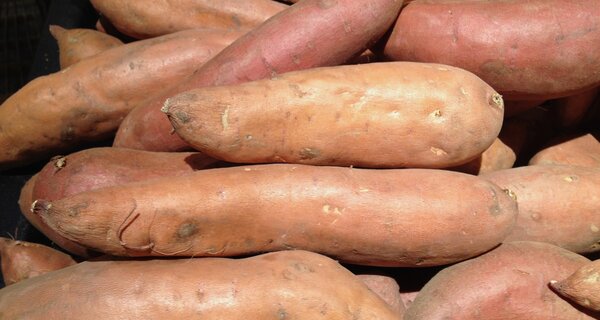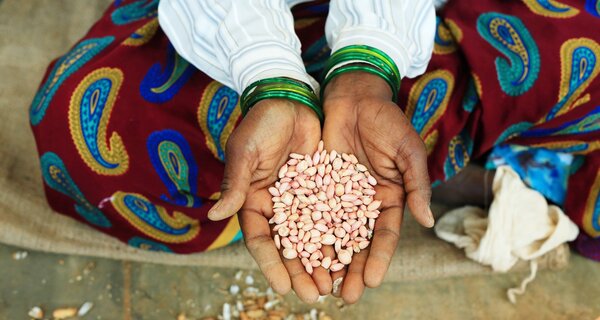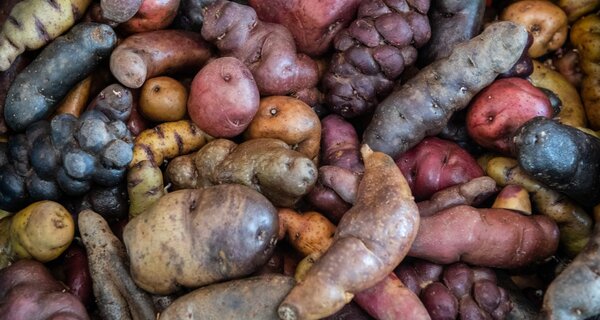Plan for Bigger, Better Yams
 Mr. Khemkham Hongphakdy, Head of Cash Crop Research and Production Group, of the Plant Research Center in Laos, describes the yam collection in the Lao National Genebank field genebank. (Photo: Michael Major for Crop Trust)
Mr. Khemkham Hongphakdy, Head of Cash Crop Research and Production Group, of the Plant Research Center in Laos, describes the yam collection in the Lao National Genebank field genebank. (Photo: Michael Major for Crop Trust)12 April 2023
Yields of yams could be boosted—and with them food security—by using their biodiversity more efficiently, according to a strategy for yam conservation facilitated by the Crop Trust.
In the United States and the Caribbean, the word “yams” generally means sweet potatoes, but that’s not the case in most other parts of the world, where it refers to a completely different kind of tuber. These yams, which in fact belong to a multitude of different species, provide food for millions of people every day, particularly in the “yam belt” of West Africa, but when it comes to research and breeding improved varieties, they are woefully neglected.
“There is a wealth of yam diversity stored in genebanks around the world, which could be used to breed varieties with higher yield and other desirable qualities, but it is not being exploited,” said Vincent Lebot, a researcher at CIRAD. “By streamlining these collections and supporting breeders, we could see real benefits to people’s lives.”
Lebot drew his conclusions while leading the development of the Global Strategy for the Conservation and Use of Yams. The global strategy is one of a series of such strategies facilitated by the Crop Trust to guide actions for conserving the priceless genetic resources of crops.
“Yams are incredibly important for food security in tropical regions,” said Peter Giovannini of the Crop Trust, who is coordinating the strategy project. “This strategy shows that there is huge untapped potential to increase the yield and quality of yams, just by working more efficiently with the genetic material that is already being stored.”
Robust, beloved, overlooked
West Africa produces most of the world’s yams: Nigeria, Côte d’Ivoire, Ghana and Benin account for more than 90% of the global output. However, yams are cultivated in about 50 tropical countries, including in South America, the Caribbean, Asia and the Pacific.
Lebot has been studying yams and other root and tuber crops for nearly 40 years, an interest sparked when a volunteer position took him to Melanesia in the early 1980s.
They are ideal plants for smallholder farmers in tropical developing countries, he says.
“Yams are very resilient and robust. They don’t need lots of nutrients, and they are amazing machines for converting solar energy to starchy organs,” Lebot said. “You can grow them on small plots, their yield per plant is very high, and they can be stored for months after harvest without losing their nutritional value. They’re almost perfect, really. But that doesn’t mean they can’t be improved.”
Yams are also used in traditional medicine and the pharmaceutical industry, and play an important role in people’s cultural life.
But yams are considered a minor crop, because of their low perceived economic value.
“Yams have to compete with cash crops and export crops, which tend to be the priority for investment, so they get neglected, including by researchers,” Lebot said. “But yams are of utmost importance to smallholder farmers, especially women who have to feed their families.”
Breeding the ideal yam
One way to support the food security of such farmers and their families is to ensure they are growing the best varieties of yams possible.
“The ideal yam has a large tuber, and good palatability, a sticky texture, good color, pleasant taste,” Lebot said.
This ideal yam could become reality, through careful cross-breeding. For example, a yam’s ploidy level—the number of chromosomes in a cell—is linked to the size of the tuber, so yam varieties with higher ploidy levels have larger yields.
Which is where genebanks come in.
Genebanks are used to store plant diversity. The greater the diversity, the more traits that are available—which means scientists have more options to breed varieties of crops that best meet people’s needs and that can adapt to new challenges, such as those caused by climate change.
Yam diversity is stored in about 30 genebanks around the world. The world’s largest collection is held by IITA, in Nigeria; the only other international collection is at the Centre for Pacific Crops and Trees in Fiji, run by the Pacific Community (SPC).
But while yams are easy to grow, they are not easy to breed. Even managing their diversity is complicated.
“We are talking about thousands of different varieties, and most of them do not produce through true seeds,” Lebot said. “So they have to be replanted or preserved in vitro—in test tubes—which makes it a very complex process.”
Several factors contribute to the complexity of breeding: male and female organs are on different plants, many varieties don’t flower, and they have different ploidy levels. And because yams are propagated vegetatively, rather than by seeds, they accumulate viruses.
Organize to optimize
But even before actually doing the breeding, breeders have trouble getting access to the diversity they need.
“Breeders often don’t even know which varieties would be good, because of poor documentation and lack of networks,” Lebot said.
This was a key finding from the strategy, for which Lebot and his colleagues sought input from genebanks, breeders and other researchers.
They found that collections around the world are isolated and have limited resources. Duplicates are also rampant, as yams’ tendency to mutate means plants that look very different may be genetically the same.
“First, we have to identify the strengths and weaknesses of existing collections,” Lebot said. “Then we need to know the ploidy and sex of each and every plant they hold, and remove duplicates, so we can build a comprehensive picture of what diversity we have in stock.”
By improving organization, communication and training, the ideal yam could become a reality.
“This strategy offers a well thought-out action plan, with good returns on investment and potentially massive benefits in the real world through increased yield and quality,” Giovannini said.
Lebot, too, is optimistic about the future of yams.
“Root crops have been neglected by the international scientific community for decades, because the focus has been on cereals and pulses,” he said. “But now it’s clear we need to assist breeders and genebanks who are working on other crops too, and yams should be high on that list, ask any farmer in West Africa or the Pacific.”
Categories: Global Crop Conservation Strategies, Yam
About the Global Crop Conservation Strategy project
The development of this Global Crop Conservation Strategy was funded by the German Federal Ministry of Food and Agriculture (BMEL) as part of a three-year project led by the Crop Trust: “Breathing New Life into the Global Crop Conservation Strategies: Providing an Evidence Base for the Global System of Ex situ Conservation of Crop Diversity.”



